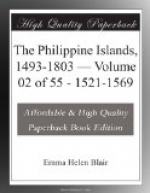[28] A map by Nicolaus Visscher, entitled Indiae Orientalis nova descriptio (undated, but probably late in the seventeenth century) shows “Philippina al Tandaya,” apparently, intended for the present Samar; but Legazpi’s relation of 1565 (post) would indicate that Tandaya was the modern Leyte. Ortelius (1570) locates the Talao Islands about half-way from Mindanao to Gilolo they are apparently the Tulour or Salibabo Islands of today.
[29] The names in brackets are the modern appellations (see Col. doc. ined. Ultramar, ii, pp. xvi, xvii).
[30] Antonio Galvano explains this by declaring that he had in 1538 (being then the Portuguese governor of the Moluccas) sent Francisco de Castro to convert the natives of the Philippines to the Catholic faith. On the island of Mindanao he was sponsor at the baptism of six kings, with their wives, children, and subjects. See Galvano’s Tratado (Hakluyt Society reprint of Hakluyt’s translation, Discoveries of the World, pp. 208, 233).
[31] See Col. doc. ined. Ultramar, ii, p. xvii.
[32] On old maps Abuyo; the aboriginal appellation of the island of Leyte (Retana-edition of Combes’s Mindanao, p. 749).
[33] Probably the cannon belonging to Magalhaes’s ship “Trinidad,” which the Portuguese seized in October, 1522; they had built a fortified post on the island of Ternate in the preceding summer, their first settlement in the Moluccas. Ternate, Tidore, Mutir, and two others, are small islands lying along the western coast of Gilolo; on them cloves grew most abundantly when Europeans first discovered the Moluccas.
[34] Bisayas or Visayas is the present appellation of the islands which lie between Luzon and Mindanao.
[35] This document is printed in both the original text and English translation.
[36] Luis de Velasco succeeded Antonio de Mendoza as viceroy of New Spain, taking his office in November, 1550, and holding it until his death (July 31, 1564). He was of an illustrious family of Castile and had held several military appointments before he became viceroy. He exercised this latter office with great ability, and favored the Indians to such an extent that he was called “the father of the Indians.” He died poor and in debt, and was buried with solemnity in the Dominican monastery at the City of Mexico.
[37] A small vessel used as a tender, to carry messages between larger vessels, etc.
[38] The Treaty of Zaragoza, q.v. vol. i, p. 222.
[39] This opinion is correct, referring as it does to the five islands lying along the coast of Gilolo.
[40] Miguel Lopez de Legazpi who, with Andres de Urdaneta, rediscovered and conquered the Philippine Islands, was born in Zubarraja in Guipuzcoa in the early part of the sixteenth century, of an old and noble family. He went to Mexico in 1545, where he became chief clerk of the cabildo of the City of Mexico. Being selected to take charge of the expedition of 1564, he succeeded by his great wisdom, patience, and forbearance, in gaining the good will of the natives. He founded Manila, where he died of apoplexy August 20, 1572. He was much lamented by all. He was succeeded as governor of the Philippines by Guido de Lavezaris.




